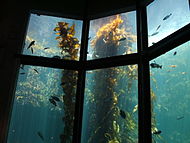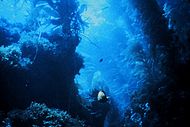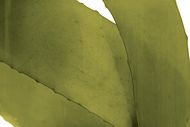Kelp
| Kelp Temporal range:[1]
| |
|---|---|
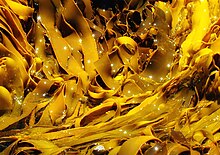
| |
| Scientific classification | |
| Domain: | Eukaryota |
| Clade: | Diaphoretickes |
| Clade: | SAR |
| Clade: | Stramenopiles |
| Phylum: | Gyrista |
| Subphylum: | Ochrophytina |
| Class: | Phaeophyceae |
| Order: | Laminariales Migula,1909[2] |
| Families | |
|
Agaraceae | |
Kelpsare largebrown algaeorseaweedsthat make up theorderLaminariales.There are about 30 differentgenera.[3]Despite its appearance, kelp is not aplantbut astramenopile,a group containing manyprotists.[4]
Kelp grows in "underwaterforests"(kelp forests) in shallow oceans. Kelps were previously thought to have appeared in theMiocene,5 to 23 million years ago based on fossils from California.[5]New fossils of kelp holdfasts from early Oligocene rocks in Washington State show that kelps were present in the northeastern Pacific Ocean by at least 32 million years ago.[6]The organisms require nutrient-rich water with temperatures between 6 and 14 °C (43 and 57 °F). They are known for their high growth rate—the generaMacrocystisandNereocystiscan grow as fast as half a metre a day, ultimately reaching 30 to 80 metres (100 to 260 ft).[7]
Through the 19th century, the word "kelp" was closely associated with seaweeds that could be burned to obtainsoda ash(primarily sodium carbonate). The seaweeds used included species from both the orders Laminariales andFucales.The word "kelp" was also used directly to refer to these processed ashes.[8]
Description[edit]

The thallus (or body) consists of flat or leaf-like structures known as blades that originate from elongated stem-like structures, the stipes. A root-like structure, theholdfast,anchors the kelp to the substrate of the ocean. Gas-filled bladders (pneumatocysts) form at the base of blades of American species, such asNereocystis lueteana,(Mert. & Post & Rupr.)[7]to hold the kelp blades close to the surface.
Growth and reproduction[edit]
Growth occurs at the base of themeristem,where the blades and stipe meet. Growth may be limited by grazing.Sea urchins,for example, can reduce entire areas tourchin barrens.[9]The kelp life cycle involves adiploidsporophyteand haploidgametophytestage. The haploid phase begins when the mature organism releases many spores, which then germinate to become male or female gametophytes.Sexual reproductionthen results in the beginning of the diploid sporophyte stage, which will develop into a mature individual.
The parenchymatous thalli are generally covered with a mucilage layer, rather than cuticle.[10]
Taxonomy[edit]
Phylogeny[edit]
Seaweed were generally considered homologues ofterrestrial plants[11],but are only very distantly related to plants, and have evolved plant-like structures throughconvergent evolution.[12]Where plants have leaves, stems, and reproductive organs, kelp have independently evolved blades, stipes, andsporangia.Withradiometric datingand the measure Ma “unequivocal minimum constraint for total groupPinaceae”vascular plantshave been measured as having evolved around 419–454 Ma[13]while the ancestors of Laminariales are much younger at 189 Ma.[14]Although these groups are distantly related as well as different in evolutionary age, there are still comparisons that can be made between the structures of terrestrial plants and kelp but in terms of evolutionary history, most of these similarities come from convergent evolution.
Some kelp species including giant kelp, have evolved transport mechanisms for organic as well asinorganic compounds,[15]similar to mechanisms of transport intreesand othervascular plants.In kelp this transportation network uses trumpet-shaped sieve elements (SEs). A 2015 study aimed to evaluate the efficiency ofgiant kelp(Macrocystis pyrifera) transport anatomy looked at 6 different laminariales species to see if they had typical vascular plant allometric relationships (if SEs had a correlation with the size of an organism). Researchers expected to find the kelp’s phloem to work similarly to a plant'sxylemand therefore display similarallometrictrends to minimizepressure gradient.The study found no universal allometric scaling between all tested structures of the laminariales species which implies that the transport network of brown algae is only just beginning to evolve to efficiently fit their current niches.[12]
Apart from undergoing convergent evolution with plants, species of kelp have undergone convergent evolution within their own phylogeny that has led toniche conservatism.[16]This niche conservatism means that some species of kelp have convergently evolved to share similar niches, as opposed to all species diverging into distinct niches throughadaptive radiation.A 2020 study looked at functional traits (blade mass per area, stiffness, strength, etc.) of 14 species of kelp and found that many of these traits evolved convergently across kelp phylogeny. With different species of kelp filling slightly different environmental niches, specifically along a wave disturbance gradient, many of these convergently evolved traits for structural reinforcement also correlate with distribution along that gradient. The wave disturbance gradient that this study refers to is the environments that this kelp inhabit have a varied level of perturbation from thetideand waves that pull at the kelp. It can be assumed from these results that niche partitioning along wave disturbance gradients is a key driver of divergence between closely related kelp.[16]
Due to the often varied and turbulent habitat that kelp inhabit,plasticityof certain structural traits has been a key for the evolutionary history of the phyla. Plasticity helps with a very important aspect of kelp adaptations to ocean environments, and that is the unusually high levels of morphologicalhomoplasybetween lineages. This in fact has made classifying brown algae difficult.[17]Kelp often have similarmorphologicalfeatures to other species within its own area since the roughness of the wave disturbance regime, but can look fairly different from other members of its own species that are found in different wave disturbance regimes. Plasticity in kelps most often involves blade morphology such as the width, ruffle, and thickness of blades.[18]Just one example is the giant bull kelpNereocystis luetkeana,which have evolved to change blade shape in order to increase drag in water and interception of light when exposed to certain environments. Bull kelp are not unique in this adaptation; many kelp species have evolved a genetic plasticity for blade shapes for different water flow habitats. So individuals of the same species will have differences to other individuals of the same species due to whathabitatthey grow in.[19]Many species have differentmorphologiesfor different wave disturbance regimes[18]but giant kelpMacrocystis integrifoliahas been found to have plasticity allowing for 4 distinct types of blade morphology depending on habitat.[20]Where many species only have two or three different blade shapes for maximizing efficiency in only two or three habitats. These different blade shapes were found to decrease breakage and increase ability tophotosynthesize.Blade adaptations like these are how kelp have evolved for efficiency in structure in a turbulent ocean environment, to the point where their stability can shape entire habitats. Apart from these structural adaptations, the evolution of dispersal methods relating to structure have been important for the success of kelp as well.
Kelp have had to adaptdispersalmethods that can make successful use ofocean currents.Buoyancyof certain kelp structures allows for species to disperse with the flow of water.[21]Certain kelp form kelp rafts, which can travel great distances away from the sourcepopulationand colonize other areas. The bull kelp genusDurvillaeaincludes six species, some that have adapted buoyancy and others that have not. Those that have adapted buoyancy have done so thanks to the evolution of a gas filled structure called thepneumatocystswhich is an adaptation that allows the kelp to float higher towards the surface to photosynthesize and also aids in dispersal by floating kelp rafts.[22]ForMacrocystis pyrifera,adaptation of pneumatocysts and raft forming have made the species dispersal method so successful that the immense spread of coast in which the species can be found has been found to actually be very recentlycolonized.This can be observed by the low genetic diversity in thesubantarcticregion.[23]Dispersal by rafts from buoyant species also explains some evolutionary history for non-buoyant species of kelp. Since these rafts commonly have hitchhikers of other diverse species, they provide a mechanism for dispersal for species that lack buoyancy. This mechanism has been recently confirmed to be the cause of some dispersal and evolutionary history for kelp species in a study done withgenomic analysis.[24]Studies of kelp structure evolution have helped in the understanding of the adaptations that have allowed for kelp to not only be extremely successful as a group of organisms but also successful as anecosystem engineerofkelp forests,some of the most diverse and dynamic ecosystems on earth.
Prominent species[edit]
- Bull kelp,Nereocystis luetkeana,a northwestern American species. Used by coastalindigenous peoplesto createfishing nets.
- Giant kelp,Macrocystis pyrifera,the largest seaweed. Found in thePacificcoast ofNorth AmericaandSouth America.
- Kombu,Saccharina japonica(formerlyLaminaria japonica) and others, several edible species of kelp found inJapan.
Species ofLaminariain the British Isles;
- Laminaria digitata(Hudson) J.V. Lamouroux (Oarweed; Tangle)
- Laminaria hyperborea(Gunnerus) Foslie (Curvie)
- Laminaria ochroleucaBachelot de la Pylaie
- Saccharina latissima(Linnaeus) J.V.Lamouroux (sea belt; sugar kelp; sugarwack)
Species ofLaminariaworldwide, listing of species atAlgaeBase:[25]
- Laminaria agardhii(NE.America)
- Laminaria bongardinaPostels et Ruprecht (Bering Sea toCalifornia)
- Laminaria cuneifolia(NE. America)
- Laminaria dentigeraKlellm. (California - America)
- Laminaria digitata(NE. America)
- Laminaria ephemeraSetchell (Sitka, Alaska, to Monterey County, California - America)
- Laminaria farlowiiSetchell (Santa Cruz, California, to Baja California - America)
- Laminaria groenlandica(NE. America)
- Laminaria longicruris(NE. America)
- Laminaria nigripes(NE. America)
- Laminaria ontermedia(NE. America)
- Laminaria pallidaGreville ex J. Agardh (South Africa)
- Laminaria platymeris(NE. America)
- Laminaria saccharina(Linnaeus) Lamouroux, synonym ofSaccharina latissima(north east Atlantic Ocean, Barents Sea south to Galicia - Spain)
- Laminaria setchelliiSilva (Aleutian Islands, Alaska to Baja California America)
- Laminaria sinclairii(Harvey ex Hooker f. ex Harvey) Farlow, Anderson et Eaton (Hope Island, British Columbia to Los Angeles, California - America)
- Laminaria solidungula(NE. America)
- Laminaria stenophylla(NE. America)

Other species in theLaminarialesthat may be considered as kelp:
- Alaria esculenta(North Atlantic)[26]
- Alaria marginataPost. & Rupr. (Alaska and California -America)
- Costaria costata(C.Ag.) Saunders (Japan; Alaska, California - America)
- Ecklonia brevipesJ. Agardh (Australia; New Zealand)
- Ecklonia maxima(Osbeck) Papenfuss (South Africa)
- Ecklonia radiata(C.Agardh) J. Agardh (Australia; Tasmania; New Zealand; South Africa)
- Eisenia arboreaAresch. (Vancouver Island, British Columbia, Montrey, Santa Catalina Island, California - America)
- Egregia menziesii(Turn.) Aresch.
- Hedophyllum sessile(C.Ag.) Setch (Alaska, California - America)
- Macrocystis pyrifera(Linnaeus, C.Agardh) (Australia; Tasmania and South Africa)
- Pleurophycus gardneriSetch. & Saund. (Alaska, California - America)
- Pterygophora californicaRupr. (Vancouver Island, British Columbia to Bahia del Ropsario, Baja California and California - America)
Non-Laminariales species that may be considered as kelp:
- Durvillea antarctica,Fucales(New Zealand,South America,andAustralia)
- Durvillea willana,Fucales (New Zealand)
- Durvillaea potatorum(Labillardière) Areschoug, Fucales (Tasmania;Australia)

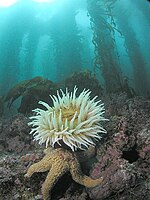
Ecology[edit]
Kelp forests[edit]
Kelp may develop dense forests with high production,[27][28]biodiversity and ecological function. Along the Norwegian coast these forests cover 5,800 km2,[29]and they support large numbers of animals.[30][31]Numeroussessile animals(sponges, bryozoans and ascidians) are found on kelp stipes and mobile invertebrate fauna are found in high densities on epiphytic algae on the kelp stipes and on kelp holdfasts.[32]More than 100,000 mobile invertebrates per square meter are found on kelp stipes and holdfasts in well-developed kelp forests.[30]While larger invertebrates and in particular sea urchins (Strongylocentrotus droebachiensis) are important secondary consumers controlling large barren ground areas on the Norwegian coast, they are scarce inside dense kelp forests.[33]
Interactions[edit]
Some animals are named after the kelp, either because they inhabit the samehabitatas kelp or because they feed on kelp. These include:
- Northern kelp crab(Pugettia producta) andgraceful kelp crab(Pugettia gracilis), Pacific coast of North America.
- Kelpfish(blenny) (e.g.,Heterosticbus rostratus,genusGibbonsia), Pacific coast of North America.
- Kelp goose (kelp hen)(Chloephaga hybrida), South America and the Falkland Islands
- Kelp pigeon (sheathbill)(Chionis albaandChionis minor), Antarctic
Conservation[edit]
Overfishing nearshore ecosystems leads to the degradation of kelp forests. Herbivores are released from their usual population regulation, leading to over-grazing of kelp and other algae. This can quickly result in barren landscapes where only a small number of species can thrive.[34][35]Other major factors which threaten kelp includemarine pollutionand the quality of water, climate changes and certain invasive species.[36]
Kelp forests are some of the most productive ecosystems in the world - they are home to a great diversity of species. Many groups, like those at theSeattle Aquarium,are studying the health, habitat, and population trends in order to understand why certain kelp (likebull kelp) thrives in some areas and not others.Remotely Operated Vehiclesare used in the surveying of sites and the data extracted is used to learn about which conditions are best suited for kelp restoration.[37]
Uses[edit]
| Nutritional value per 100 g (3.5 oz) | |
|---|---|
| Energy | 180 kJ (43 kcal) |
9.57 g | |
| Sugars | 0.6 |
| Dietary fiber | 1.3 g |
0.56 g | |
1.68 g | |
| Vitamins | Quantity %DV† |
| Thiamine (B1) | 4% 0.05 mg |
| Riboflavin (B2) | 12% 0.15 mg |
| Niacin (B3) | 3% 0.47 mg |
| Pantothenic acid (B5) | 13% 0.642 mg |
| Folate (B9) | 45% 180 μg |
| Vitamin C | 3% 3 mg |
| Vitamin E | 6% 0.87 mg |
| Vitamin K | 55% 66 μg |
| Minerals | Quantity %DV† |
| Calcium | 13% 168 mg |
| Iron | 16% 2.85 mg |
| Magnesium | 29% 121 mg |
| Manganese | 9% 0.2 mg |
| Phosphorus | 3% 42 mg |
| Potassium | 3% 89 mg |
| Sodium | 10% 233 mg |
| Zinc | 11% 1.23 mg |
| †Percentages estimated usingUS recommendationsfor adults,[38]except for potassium, which is estimated based on expert recommendation fromthe National Academies.[39] | |
Giant kelp can be harvested fairly easily because of its surface canopy and growth habit of staying in deeper water.
Kelp ash is rich iniodineandalkali.In great amount, kelp ash can be used insoapandglassproduction. Until theLeblanc processwas commercialized in the early 19th century, burning of kelp in Scotland was one of the principal industrial sources of soda ash (predominantlysodium carbonate).[40]Around 23 tons of seaweed was required to produce 1 ton of kelp ash. The kelp ash would consist of around 5% sodium carbonate.[41]
Once the Leblanc Process became commercially viable in Britain during the 1820s, common salt replaced kelp ash as raw material for sodium carbonate. Though the price of kelp ash went into steep decline, seaweed remained the only commercial source of iodine. To supply the new industry in iodine synthesis, kelp ash production continued in some parts of West and North Scotland, North West Ireland and Guernsey. The speciesSaccharina latissimayielded the greatest amount of iodine (between 10 and 15 lbs per ton) and was most abundant in Guernsey. Iodine was extracted from kelp ash using alixiviationprocess.[42]As with sodium carbonate however, mineral sources eventually supplanted seaweed in iodine production.[43]
Alginate,a kelp-derived carbohydrate, is used to thicken products such asice cream,jelly,salad dressing,andtoothpaste,as well as an ingredient in exoticdog foodand in manufactured goods.[44][45][46]Alginate powder is also used frequently in general dentistry and orthodontics for making impressions of the upper and lower arches.[47]Kelp polysaccharides are used in skin care as gelling ingredients and because of the benefits provided byfucoidan.[citation needed]
Kombu( côn bố in Japanese, and hải đái in Chinese,Saccharina japonicaand others), several Pacific species of kelp, is a very important ingredient in Chinese, Japanese, and Korean cuisines. Kombu is used to flavor broths and stews (especiallydashi), as a savory garnish (tororo konbu) for rice and other dishes, as a vegetable, and a primary ingredient in popular snacks (such astsukudani). Transparent sheets of kelp (oboro konbu) are used as an edible decorative wrapping for rice and other foods.[48]
Kombu can be used to soften beans during cooking, and to help convert indigestible sugars and thus reduce flatulence.[49]

In Russia, especially in theRussian Far East,and former Soviet Union countries several types of kelp are of commercial importance:Saccharina latissima,Laminaria digitata,Saccharina japonica.Known locally as "Sea Cabbage" (Морская капуста in Russian), it comes in retail trade in dried or frozen, as well as in canned form and used as filler in different types of salads, soups and pastries.[50]
Because of its high concentration of iodine, brown kelp (Laminaria) has been used to treatgoiter,an enlargement of the thyroid gland caused by a lack of iodine, since medieval times.[51]An intake of roughly 150 micrograms of iodine per day is beneficial for preventing hypothyroidism. Overconsumption can lead to kelp-inducedthyrotoxicosis.[52]
In 2010, researchers found thatalginate,thesoluble fibresubstance in sea kelp, was better at preventing fat absorption than most over-the-counter slimming treatments in laboratory trials. As a food additive, it may be used to reduce fat absorption and thus obesity.[53]Kelp in its natural form has not yet been demonstrated to have such effects.
Kelp's rich iron content can help prevent iron deficiency.[54]
Commercial production[edit]
Commercial production of kelp harvested from its natural habitat has taken place in Japan for over a century. Many countries today produce and consume laminaria products; the largest producer is China.Laminaria japonica,the important commercial seaweed, was first introduced into China in the late 1920s from Hokkaido, Japan. Yetmaricultureof this alga on a very large commercial scale was realized in China only in the 1950s. Between the 1950s and the 1980s, kelp production in China increased from about 60 to over 250,000 dry weight metric tons annually.
In culture[edit]

Some of the earliest evidence for human use of marine resources, coming from Middle Stone Age sites in South Africa, includes the harvesting of foods such asabalone,limpets,andmusselsassociated with kelp forest habitats.
In 2007, Erlandson et al. suggested that kelp forests around the Pacific Rim may have facilitated the dispersal of anatomically modern humans following a coastal route from Northeast Asia to the Americas. This "kelp highway hypothesis" suggested that highly productive kelp forests supported rich and diverse marine food webs in nearshore waters, including many types of fish, shellfish, birds, marine mammals, and seaweeds that were similar from Japan to California, Erlandson and his colleagues also argued that coastal kelp forests reduced wave energy and provided a linear dispersal corridor entirely at sea level, with few obstacles to maritime peoples. Archaeological evidence from California's Channel Islands confirms that islanders were harvesting kelp forest shellfish and fish, beginning as much as 12,000 years ago.
During theHighland Clearances,many Scottish Highlanders were moved on to areas of estates known ascrofts,and went to industries such as fishing and kelping (producing soda ash from the ashes of kelp). At least until the 1840s, when there were steep falls in the price of kelp, landlords wanted to create pools of cheap or virtually free labour, supplied by families subsisting in new crofting townships. Kelp collection and processing was a very profitable way of using this labour, and landlords petitioned successfully for legislation designed to stop emigration. The profitability of kelp harvesting meant that landlords began to subdivide their land for small tenant kelpers, who could now afford higher rent than their gentleman farmer counterparts.[55]But the economic collapse of the kelp industry in northernScotlandduring the 1820s led to further emigration, especially toNorth America.[citation needed]
Natives of theFalkland Islandsare sometimesnicknamed"Kelpers".[56][57]This designation is primarilyapplied by outsiders rather than the natives themselves.
In Chineseslang,"kelp" (simplified Chinese:Hải đái;traditional Chinese:Hải đái;pinyin:hǎi dài), is used to describe an unemployed returnee.[clarification needed]It has negative overtones, implying the person is drifting aimlessly, and is also a homophonic expression (Chinese:Hải đãi;pinyin:hǎidài,literally "sea waiting" ). This expression is contrasted with the employed returnee, having a dynamic ability to travel across the ocean: the "sea turtle" (simplified Chinese:Hải quy;traditional Chinese:Hải quy;pinyin:hǎi gūi) and is also homophonic with another word (simplified Chinese:Hải quy;traditional Chinese:Hải quy;pinyin:hǎi gūi,literally "sea return" ).
Gallery[edit]
-
Giant kelpin Monterey Bay Aquarium'sKelp Forest exhibit
-
Blue rockfish in kelp forest
-
An underwater shot of a kelp forest
-
A close up view ofEcklonia maxima,giant brown kelp
-
Washed-up kelp found along the coast ofLa Jolla Shores
-
Scuba divingin a kelp forest inCalifornia
See also[edit]
- Bladder wrack– Species of Phaeophyceae
- Blue carbon– Carbon stored in coastal and marine ecosystems
- Durvillaea,also known as southern bull kelps – Genus of seaweeds
- Wrack zone– Organic material deposited at high tide on beaches and other coastal area
- Sea lettuce– Genus of seaweeds
- Aquaculture of giant kelp
References[edit]
- ^William Miller, III (13 October 2011).Trace Fossils: Concepts, Problems, Prospects: Chapter 13 "Zoophycosand the Role of Type Specimens in Ichnotaxonomy by Davide Olivero.Elsevier. pp. 224–226.ISBN978-0-08-047535-6.Retrieved1 April2013.
- ^Migula, W. (1909).Kryptogamen-Flora von Deutschland, Deutsch-Österreich und der Schweiz. Band II. Algen. 2. Teil. Rhodophyceae, Phaeophyceae, Characeae.Gera: Verlag Friedriech von Zezschwitz. pp. i–iv, 1–382, 122 (41 col.) pls.
- ^Bolton, John J. (23 July 2010)."The biogeography of kelps (Laminariales, Phaeophyceae): a global analysis with new insights from recent advances in molecular phylogenetics".Helgoland Marine Research.64(4): 263–279.Bibcode:2010HMR....64..263B.doi:10.1007/s10152-010-0211-6.
- ^Silberfeld, Thomas; Rousseau, Florence; de Reviers, Bruno (2014). "An Updated Classification of Brown Algae (Ochrophyta, Phaeophyceae)".Cryptogamie, Algologie.35(2): 117–156.doi:10.7872/crya.v35.iss2.2014.117.S2CID86227768.
- ^University of California Museum of Paleontology: The Miocene Epoch
- ^Kiel, S., J.L. Goedert, T.L. Huynh, M. Krings, D. Parkinson, R. Romero, C.V. Looy. 2024. Early Oligocene kelp holdfasts and stepwise evolution of the kelp ecosystem in the North Pacific. PNAS 121: e2317054121
- ^abThomas, D. 2002.Seaweeds.The Natural History Museum, London, p. 15.ISBN0-565-09175-1
- ^"Kelp," inOxford English Dictionary (Second Edition).Oxford University Press, 1989. Retrieved 1 December 2006
- ^Norderhaug, KM., Christie, H. 2009. Sea urchin grazing and kelp re-vegetation in the NE Atlantic. Marine Biology Research 5: 515-528.Estuarine, Coastal and Shelf Science95: 135-144
- ^Fritsch, F. E. (1945).Structure and Reproduction of the Algae, Volume 2.Cambridge University Press. p. 226.ISBN9780521050425.OCLC223742770.
- ^Darwin, C.The Voyage of the Beagle;P. F. Collier & Son Corporation: New York, 1860
- ^abDrobnitch, Sarah Tepler; Jensen, Kaare H.; Prentice, Paige; Pittermann, Jarmila (2015-10-07)."Convergent evolution of vascular optimization in kelp (Laminariales)".Proceedings of the Royal Society B: Biological Sciences.282(1816): 20151667.doi:10.1098/rspb.2015.1667.ISSN0962-8452.PMC4614777.PMID26423844.
- ^Clarke, John T.; Warnock, Rachel C. M.; Donoghue, Philip C. J. (October 2011)."Establishing a time‐scale for plant evolution".New Phytologist.192(1): 266–301.doi:10.1111/j.1469-8137.2011.03794.x.ISSN0028-646X.PMID21729086.
- ^Silberfeld, Thomas; Leigh, Jessica W.; Verbruggen, Heroen; Cruaud, Corinne; de Reviers, Bruno; Rousseau, Florence (August 2010). "A multi-locus time-calibrated phylogeny of the brown algae (Heterokonta, Ochrophyta, Phaeophyceae): Investigating the evolutionary nature of the" brown algal crown radiation "".Molecular Phylogenetics and Evolution.56(2): 659–674.doi:10.1016/j.ympev.2010.04.020.PMID20412862.
- ^Manley, Steven L. (March 1983). "Composition of Sieve Tube Sap from Macrocystis Pyrifera (Phaeophyta) With Emphasis on the Inorganic Constituents".Journal of Phycology.19(1): 118–121.doi:10.1111/j.0022-3646.1983.00118.x.ISSN0022-3646.S2CID84778708.
- ^abStarko, Samuel; Demes, Kyle W.; Neufeld, Christopher J.; Martone, Patrick T. (October 2020). Carrington, Emily (ed.)."Convergent evolution of niche structure in Northeast Pacific kelp forests".Functional Ecology.34(10): 2131–2146.doi:10.1111/1365-2435.13621.ISSN0269-8463.
- ^Draisma, Stefano G. A.; Prud'Homme van Reine, Willem F.; Stam, Wytze T.; Olsen, Jeanine L. (August 2001). "A Reassessment of Phylogenetic Relationships Within the Phaeophyceae Based on Rubisco Large Subunit and Ribosomal DNA Sequences".Journal of Phycology.37(4): 586–603.doi:10.1046/j.1529-8817.2001.037004586.x.ISSN0022-3646.S2CID83876632.
- ^abKoehl, M. A. R.; Silk, W. K.; Liang, H.; Mahadevan, L. (December 2008)."How kelp produce blade shapes suited to different flow regimes: A new wrinkle".Integrative and Comparative Biology.48(6): 834–851.doi:10.1093/icb/icn069.ISSN1540-7063.PMID21669836.
- ^Lobban, C. S., Wynne, M. J., & Lobban. (1981).The Biology of Seaweeds.University of California Press.
- ^Hurd, C. L.; Harrison, P. J.; Druehl, L. D. (August 1996). "Effect of seawater velocity on inorganic nitrogen uptake by morphologically distinct forms of Macrocystis integrifolia from wave-sheltered and exposed sites".Marine Biology.126(2): 205–214.doi:10.1007/BF00347445.ISSN1432-1793.S2CID84195060.
- ^Garden, Christopher J.; Currie, Kim; Fraser, Ceridwen I.; Waters, Jonathan M. (2014-03-31). "Rafting dispersal constrained by an oceanographic boundary".Marine Ecology Progress Series.501:297–302.Bibcode:2014MEPS..501..297G.doi:10.3354/meps10675.ISSN0171-8630.
- ^Fraser, Ceridwen I.; Velásquez, Marcel; Nelson, Wendy A.; Macaya, Erasmo C.; Hay, Cameron H. (February 2020). Buschmann, A. (ed.)."The Biogeographic Importance of Buoyancy in Macroalgae: A Case Study of the Southern Bull‐Kelp Genus Durvillaea (Phaeophyceae), Including Descriptions of Two New Species 1".Journal of Phycology.56(1): 23–36.doi:10.1111/jpy.12939.ISSN0022-3646.PMID31642057.S2CID204850695.
- ^Macaya, E. C.; Zuccarello, G. C. (2010-12-16)."Genetic structure of the giant kelp Macrocystis pyrifera along the southeastern Pacific".Marine Ecology Progress Series.420:103–112.Bibcode:2010MEPS..420..103M.doi:10.3354/meps08893.ISSN0171-8630.
- ^Fraser, Ceridwen I.; McGaughran, Angela; Chuah, Aaron; Waters, Jonathan M. (August 2016). "The importance of replicating genomic analyses to verify phylogenetic signal for recently evolved lineages".Molecular Ecology.25(15): 3683–3695.doi:10.1111/mec.13708.hdl:11343/291926.ISSN0962-1083.PMID27238591.S2CID206183570.
- ^AlgaeBase Laminariales
- ^"Dabberlocks (Alaria esculenta)".The Marine Life Information Network.Retrieved1 August2019.
- ^Pessarrodona, A.; Assis, J.; Filbee-Dexter, K.; Burrows, M. T.; Gattuso, J-P.; Duarte, C. M.; Krause-Jensen, D.; Moore, P. J.; Smale, D. A.; Wernberg, T. (23 July 2020)."Global Seaweed Productivity".Science Advances.8(37): eabn2465.doi:10.1126/sciadv.abn2465.hdl:10754/681467.PMC9473579.PMID36103524.
- ^Abdullah, M.I., Fredriksen, S., 2004. Production, respiration and exudation of dissolved organic matter by the kelp Laminaria hyperborea along the west coast of Norway. Journal of the Marine Biological Association of the UK 84: 887.
- ^Rinde, E., 2009. Dokumentasjon av modellerte marine Naturtyper i DNs Naturbase. Førstegenerasjonsmodeller til kommunenes startpakker for kartlegging av marine naturtyper 2007. NIVA report, 32 pp.
- ^abChristie, H., Jørgensen, N.M., Norderhaug, K.M., Waage-Nielsen, E., 2003. Species distribution and habitat exploitation of fauna associated with kelp (Laminaria hyperborea) along the Norwegian coast. Journal of the Marine Biological Association of the UK 83, 687-699.
- ^Jørgensen, N.M., Christie, H., 2003. l Diurnal, horizontal and vertical dispersal of kelp associated fauna. Hydrobiologia 50, 69-76.
- ^Norderhaug, K.M., Christie, H., Rinde, E., 2002. Colonisation of kelp imitations by epiphyte and holdfast fauna; a study of mobility patterns. Marine Biology 141, 965-973.
- ^Norderhaug, K.M., Christie, H., 2009. Sea urchin grazing and kelp re-vegetation in the NE Atlantic. Marine Biology Research 5, 515-528.
- ^Dayton, P.K. 1985a. Ecology of kelp communities.Annual Review of Ecology and Systematics16: 215-245.
- ^Sala, E., C.F. Bourdouresque and M. Harmelin-Vivien. 1998. Fishing, trophic cascades, and the structure of algal assemblages: evaluation of an old but untested paradigm.Oikos82: 425-439.
- ^Planet, Team (2012-01-12)."Green Glossary: Kelp Forests: Other Marine Life: Animal Planet".Animals.howstuffworks.com. Archived fromthe originalon 2012-10-24.Retrieved2013-02-12.
- ^"Kelp and coastal ecosystems".Seattle Aquarium.Retrieved2024-05-29.
- ^United States Food and Drug Administration(2024)."Daily Value on the Nutrition and Supplement Facts Labels".FDA.Archivedfrom the original on 2024-03-27.Retrieved2024-03-28.
- ^National Academies of Sciences, Engineering, and Medicine; Health and Medicine Division; Food and Nutrition Board; Committee to Review the Dietary Reference Intakes for Sodium and Potassium (2019). Oria, Maria; Harrison, Meghan; Stallings, Virginia A. (eds.).Dietary Reference Intakes for Sodium and Potassium.The National Academies Collection: Reports funded by National Institutes of Health. Washington, DC: National Academies Press (US).ISBN978-0-309-48834-1.PMID30844154.Archivedfrom the original on 2024-05-09.Retrieved2024-06-21.
- ^Clow, Archibald; Clow, Nan L. (1952).Chemical Revolution.Ayer Co Pub. pp.65–90.ISBN978-0-8369-1909-7.OCLC243798097.
- ^Jonathan Pereira, Fred B. Kilmer, The Elements of Materia Medica and Therapeutics, Volume 1, 1854, p. 558
- ^Edward C. C. Stanford, Wentworth L. Scott, ‘The Economic Applications of Seaweed’, February 14, 1862, Journal of the Royal Society of Arts, Vol 10, No. 482, 185-199
- ^John J. McKetta Jr. Taylor & Francis, Encyclopaedia of Chemical Processing and Design: Volume 27 - Hydrogen Cyanide to Ketones Dimethyl (Acetone), 1988, p. 283
- ^Brownlee, Iain A.; Seal, Chris J.; Wilcox, Matthew; Dettmar, Peter W.; Pearson, Jeff P. (2009)."Applications of Alginates in Food".In Rehm, Bernd H. A. (ed.).Alginates: Biology and Applications.Microbiology Monographs. Vol. 13. Springer Berlin Heidelberg. pp. 211–228.doi:10.1007/978-3-540-92679-5_9.ISBN9783540926795.Retrieved2019-01-25.
- ^Uzunović, Alija; Mehmedagić, Aida; Lačević, Amela; Vranić, Edina (2004-11-20)."Formulation ingredients for toothpastes and mouthwashes".Bosnian Journal of Basic Medical Sciences.4(4): 51–58.doi:10.17305/bjbms.2004.3362.ISSN1840-4812.PMC7245492.PMID15628997.
- ^Rychen, Guido; Aquilina, Gabriele; Azimonti, Giovanna; Bampidis, Vasileios; Bastos, Maria de Lourdes; Bories, Georges; Chesson, Andrew; Cocconcelli, Pier Sandro; Flachowsky, Gerhard (2017)."Safety and efficacy of sodium and potassium alginate for pets, other non food-producing animals and fish".EFSA Journal.15(7): e04945.doi:10.2903/j.efsa.2017.4945.ISSN1831-4732.PMC7009951.PMID32625597.
- ^Powers, John M. Powers. Craig's Restorative Dental Materials, 12th Edition. C.V. Mosby, 022006. p. 270
- ^Kazuko, Emi:Japanese Cooking,p. 78, Hermes House, 2002, p. 78.ISBN0-681-32327-2
- ^Graimes, Nicola:The Best-Ever Vegetarian Cookbook,Barnes & NobleBooks, 1999, p. 59.ISBN0-7607-1740-0
- ^"Features of the Far Eastern cuisine".www.eastrussia.ru.Archived fromthe originalon 2021-01-16.Retrieved2021-01-14.
- ^Iodine Helps Kelp Fight Free Radicals and May Aid Humans, TooNewswise, Retrieved on July 8, 2008.
- ^Leung, Angela M.; Braverman, Lewis E. (March 2014)."Consequences of excess iodine".Nature Reviews Endocrinology.10(3): 136–142.doi:10.1038/nrendo.2013.251.PMC3976240.PMID24342882.
- ^"Is Seaweed The Answer To A Dieter's Prayer?".Sky News. March 22, 2010. Archived fromthe originalon March 25, 2010.RetrievedMarch 23,2010.
- ^Miller, Eric P.; Auerbach, Hendrik; Schünemann, Volker; Tymon, Teresa; Carrano, Carl J. (20 April 2016)."Surface binding, localization and storage of iron in the giant kelp Macrocystis pyrifera".Metallomics.8(4): 403–411.doi:10.1039/C6MT00027D.ISSN1756-591X.PMID27009567.
- ^J. M. Bumsted, The People's Clearance: Highland Emigration to British North America, 1770-1815, 1981
- ^[1]allwords.com definition for "Kelper",
- ^[2]dictionary.com definition for "Kelper"
Further reading[edit]
- Druehl, L.D. 1988. Cultivated edible kelp.inAlgae and Human Affairs.Lembi, C.A. and Waaland, J.R. (Editors) 1988.ISBN0 521 32115 8.
- Erlandson, J.M., M.H. Graham, B.J. Bourque, D. Corbett, J.A. Estes, & R.S. Steneck. 2007. The Kelp Highway hypothesis: marine ecology, the coastal migration theory, and the peopling of the Americas. Journal of Island and Coastal Archaeology 2:161-174.
- Eger, A. M., Layton, C., McHugh, T. A, Gleason, M., and Eddy, N. (2022).Kelp Restoration Guidebook: Lessons Learned from Kelp Projects Around the World.The Nature Conservancy, Arlington, VA, USA.
External links[edit]
 Media related toLaminarialesat Wikimedia Commons
Media related toLaminarialesat Wikimedia Commons Data related toLaminarialesat Wikispecies
Data related toLaminarialesat Wikispecies

